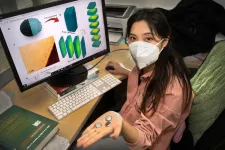Analyzing tumor microenvironment at single cell level sheds light on metastatic melanoma outcomes
Findings may help better direct targeted treatments by identifying patient response in advance of therapy
2021-06-03
(Press-News.org) TAMPA, Fla. -- There are several new treatment options available for patients with advanced melanoma. While these therapies have greatly improved the prognosis for patients, each person can respond to the treatments differently. Treatment of melanomas that have spread to the central nervous system is especially challenging. In a new article published in Clinical Cancer Research, Moffitt Cancer Center researchers reveal how different therapies impact the surrounding immune environment of metastatic melanoma tumors according to location and identify a rare population of immune cells that is associated with improved overall survival.
Different types of cancer tend to spread to specific sites throughout the body. Common sites of melanoma metastases are the brain, lungs, liver and bones. Approximately 40% to 60% of melanoma patients develop metastatic disease within the central nervous system, while 5% of patients develop metastatic disease within the area of the leptomeninges, the two innermost layers of tissue that cover the brain and spinal cord, and the cerebrospinal fluid. Patients with leptomeningeal melanoma metastases have a very poor prognosis, with a mean survival of only eight to 10 weeks. Despite this poor prognosis, a handful of patients with leptomeningeal melanoma metastases show increased survival, but the reasons for this are unclear.
"Overall, we know very little about the tumors at this site or why they prove to be so deadly. We hope these insights will lead to the development of novel therapies, with the ultimate goal of improving clinical outcomes of patients with leptomeningeal melanoma metastases," said Inna Smalley, Ph.D., first author on this study and assistant member of the Cancer Physiology Department.
Moffitt researchers want to improve their understanding of why some metastatic melanoma patients respond better than others and determine which cellular factors contribute to these improved responses across different metastatic sites. They analyzed the RNA expression patterns of individual melanoma and immune cells from 26 patients with metastatic melanoma of the skin, brain and leptomeninges/cerebrospinal fluid, and used this information to determine the specific immune cell types that were present within each sample. They discovered that the types of cells within the tumor microenvironment varied according to the site of metastasis. Leptomeningeal melanoma metastases were characterized by an immune-suppressed environment, with a high percentage of dysfunctional CD4 and CD8 T cells that are incapable of mounting an immune response, and low levels of B cells. Alternatively, samples from brain and skin metastases were much more alike in their immune environment, with an enrichment for activated CD4 T cells.
The researchers analyzed how the immune environment of metastatic sites is modulated by different regimens and what types of immune cells are associated with better responses. They compared data from a patient with leptomeningeal melanoma metastases who had a good response to treatment and survived for more than 38 months, to data from five patients who had poor responses to treatment. They found that the long-term survivor had an immune environment that was more like patients without leptomeningeal disease, whereas poor responding patients had immune environments characterized by immunosuppressive myeloid cells and exhausted lymphocytes, a recipe for diminished antitumor responses. Samples derived after treatment revealed that the long-term survivor had cells characteristic of an active immune response, and patients who responded poorly to therapy did not have these cells present.
A further analysis of dendritic cells that play an important role in therapy response showed that a subpopulation, called DC3s, were associated with improved overall survival and the presence of an active T cell immune response, regardless of the site of metastasis or treatment history. The researchers confirmed the importance of DC3s to patient outcomes through preclinical studies in mouse models.
"Our study provides the first insights into the immune microenvironment of patients with leptomeningeal melanoma metastases and helps to clarify why these individuals do so poorly," said Keiran Smalley, Ph.D., director of the Donald A. Adam Melanoma and Skin Cancer Center of Excellence at Moffitt. "The tissue microenvironments of brain and leptomeningeal metastatic sites are very distinct and show differential responses to systemic therapy."
INFORMATION:
This study was supported by the National Institutes of Health (P50 CA168536, R21 CA198550, R21 CA216756, K99 CA226679), Department of Defense, Melanoma Research Foundation, Moffitt DRP Innovation Core Project Award and a donation to the Melanoma and Skin Cancer Center of Excellence by Lesa Kennedy and Bill Christy.
About Moffitt Cancer Center
Moffitt is dedicated to one lifesaving mission: to contribute to the prevention and cure of cancer. The Tampa-based facility is one of only 51 National Cancer Institute-designated Comprehensive Cancer Centers, a distinction that recognizes Moffitt's scientific excellence, multidisciplinary research, and robust training and education. Moffitt is the No. 11 cancer hospital and has been nationally ranked by U.S. News & World Report since 1999. Moffitt's expert nursing staff is recognized by the American Nurses Credentialing Center with Magnet® status, its highest distinction. With more than 7,000 team members, Moffitt has an economic impact in the state of $2.4 billion. For more information, call 1-888-MOFFITT (1-888-663-3488), visit MOFFITT.org, and follow the momentum on Facebook, Twitter, Instagram and YouTube.
ELSE PRESS RELEASES FROM THIS DATE:
2021-06-03
The pros make it look easy, but making a movie with a drone can be anything but.
First, it takes skill to fly the often expensive pieces of equipment smoothly and without crashing. And once you've mastered flying, there are camera angles, panning speeds, trajectories and flight paths to plan.
With all the sensors and processing power onboard a drone and embedded in its camera, there must be a better way to capture the perfect shot.
"Sometimes you just want to tell the drone to make an exciting video," said Rogerio Bonatti, a Ph.D. candidate in Carnegie Mellon University's Robotics Institute.
Bonatti was part ...
2021-06-03
North Carolina State University researchers have developed a computer simulation tool to predict when and where pests and diseases will attack crops or forests, and also test when to apply pesticides or other management strategies to contain them.
"It's like having a bunch of different Earths to experiment on to test how something will work before spending the time, money and effort to do it," said the study's lead author Chris Jones, research scholar at North Carolina State University's Center for Geospatial Analytics.
In the journal Frontiers in Ecology and the Environment, researchers reported on their efforts to develop and test ...
2021-06-03
KINGSTON, R.I. - June 3, 2021 - Scientists from the University of Rhode Island have taken the first steps toward understanding the function of microbes that live on and in Eastern oysters, which may have implications for oyster health and the management of oyster reefs and aquaculture facilities.
"Marine invertebrates like oysters, corals and sponges have a very active microbiome that could potentially play a role in the function of the organism itself," said Ying Zhang, URI associate professor of cell and molecular biology. "We know very little about whether there are resident microbes in oysters, and if there are, what their function may be or how they may help or bring harm to the oyster."
Zhang and doctoral student Zachary Pimentel extracted the DNA of microbes living in ...
2021-06-03
ANN ARBOR, Mich. -- A different type of surge may be on the way more than a year into the pandemic - a baby surge.
The COVID-19 shutdown initially seemed to hit pause on pregnancy and birth rates, new research from one major hospital system suggests, but that trend is quickly reversing.
"Birth rates declined early on in the pandemic, but we expect a dramatic rebound soon," says lead author Molly Stout, M.D., MSci, maternal fetal medicine director at Michigan Medicine Von Voigtlander Women's Hospital.
"We're already seeing signs of a summer baby surge."
While infectious ...
2021-06-03
UPTON, NY--A team of researchers led by chemists at the U.S. Department of Energy's (DOE) Brookhaven National Laboratory has studied an elusive property in cathode materials, called a valence gradient, to understand its effect on battery performance. The findings, published in Nature Communications, demonstrated that the valence gradient can serve as a new approach for stabilizing the structure of high-nickel-content cathodes against degradation and safety issues.
High-nickel-content cathodes have captured the attention of scientists for their high capacity, a chemical property that could power electric vehicles over much longer distances than current batteries support. Unfortunately, the high nickel content also causes these cathode materials to degrade more quickly, creating cracks ...
2021-06-03
The South Pole and the rest of East Antarctica is cold now and was even more frigid during the most recent ice age around 20,000 years ago -- but not quite as cold as previously believed.
University of Washington glaciologists are co-authors on two papers that analyzed Antarctic ice cores to understand the continent's air temperatures during the most recent glacial period. The results help understand how the region behaves during a major climate transition.
In one paper, an international team of researchers, including three at the UW, analyzed seven ice cores from across West and East Antarctica. The results published June 3 in Science show warmer ice age temperatures in the eastern part of the continent.
The team ...
2021-06-03
Scientists have gained the best view yet of the brightest explosions in the universe: A specialised observatory in Namibia has recorded the most energetic radiation and longest gamma-ray afterglow of a so-called gamma-ray burst (GRB) to date. The observations with the High Energy Stereoscopic System (H.E.S.S.) challenge the established idea of how gamma-rays are produced in these colossal stellar explosions which are the birth cries of black holes, as the international team reports in the journal Science.
"Gamma-ray bursts are bright X-ray and gamma-ray flashes observed in the sky, emitted by distant extragalactic sources," explains DESY scientist Sylvia Zhu, one of the authors of the ...
2021-06-03
The biggest shark attack in history did not involve humans.
A new study by Earth scientists from Yale and the College of the Atlantic has turned up a massive die-off of sharks roughly 19 million years ago. It came at a period in history when there were more than 10 times more sharks patrolling the world's oceans than there are today.
For now, researchers don't know the cause of the shark die-off.
"We happened upon this extinction almost by accident," said Elizabeth Sibert, a Hutchinson postdoctoral associate in Yale's Department of Earth and Planetary Sciences and ...
2021-06-03
Scientists have developed the first cells that can construct artificial polymers from building blocks that are not found in nature, by following instructions the researchers encoded in their genes.
The study, led by scientists from the Medical Research Council (MRC) Laboratory of Molecular Biology, in Cambridge, UK, also found the synthetic genome made the bacteria entirely resistant to infection by viruses.
The scientists say their research could lead to the development of new polymers - large molecules made of many repeating units, such as proteins, plastics, and many drugs including antibiotics - and make it easier to ...
2021-06-03
Hydrogels are polymer materials made mostly from water. They can be used in a wide range of medical and other applications. However, previous incarnations of the materials suffered from repeated mechanical stress and would easily become deformed. A novel crystal that can reversibly form and deform, allows hydrogels to rapidly recover from mechanical stress. This opens up the use of such biocompatible materials in the field of artificial joints and ligaments.
Many of us suffer the occasional sports injury or experience some kind of pain relating to joints and ligaments at some point in our lives. ...
LAST 30 PRESS RELEASES:
[Press-News.org] Analyzing tumor microenvironment at single cell level sheds light on metastatic melanoma outcomes
Findings may help better direct targeted treatments by identifying patient response in advance of therapy



